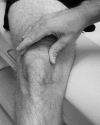Medial plica irritation: diagnosis and treatment
- PMID: 19468899
- PMCID: PMC2684145
- DOI: 10.1007/s12178-007-9006-z
Medial plica irritation: diagnosis and treatment
Abstract
Medial plica irritation of the knee is a very common source of anterior knee pain. Patients can complain of pain over the anteromedial aspect of their knees and describe episodes of crepitation, catching, and pseudo-locking events with activities. Patients commonly have pain on physical examination upon rolling the plica fold of tissue over the anteromedial aspect of their knees and often have tight hamstrings. The majority of the patients will respond well to a non-operative treatment program consisting of quadriceps strengthening along with concurrent hamstring stretching. In cases which do not respond initially to an exercise program, an intraarticular steroid injection may be indicated. In those few patients who do not respond to a non-operative treatment program, an arthroscopic resection of their medial plica may be indicated, especially in those cases where a shelf-like plica has been found to be causing damage to the articular cartilage of the medial femoral condyle.
Figures

















References
-
- Broom MJ, Fulkerson JP. The plica syndrome: a new perspective. Orthop Clin North Am. 1986;17(2):279–81. - PubMed
-
- Dye SF, Vaupel GL, Dye CC. Conscious neurosensory mapping of the internal structures of the human knee without intraarticular anesthesia. Am J Sports Med. 1998;26:773–7. - PubMed
-
- Ewing JW. Plica: pathologic or not? J Am Acad Orthop Surg. 1993;1:117–21. - PubMed
LinkOut - more resources
Full Text Sources

